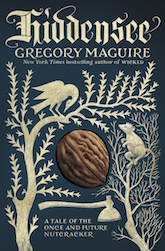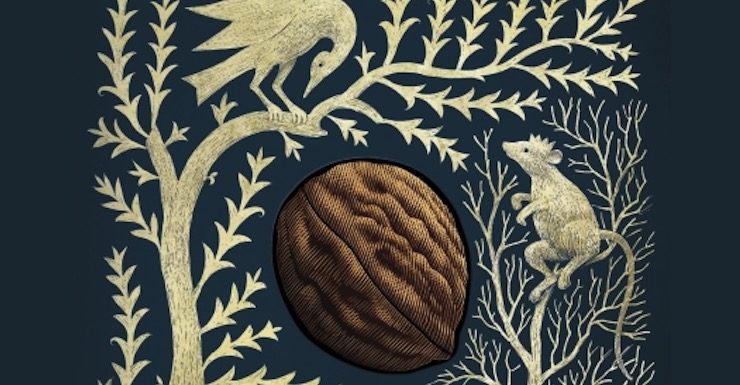Gregory Maguire has built a career out of deconstructing fairy tales and famous works of fantasy through the platform of the novel, examining creations as varied as The Wonderful Wizard of Oz, Ebenezer Scrooge, Alice in Wonderland, Cinderella and Snow White. In Hiddensee, he takes on another popular fantasy: the tale of the Nutcracker.
Or at least part of it.
The story of the Nutcracker was first told in a long, intricate novella by E.T.A. Hoffman in 1819. Pyotr Ilrich Tchaikovsky later transformed the tale into a ballet which became a staple of the holiday season. If for some reason you’ve managed to miss the nearly ubiquitous ballet, or can only remember the even more ubiquitous music from it that inflicts our eardrums on an annual basis, the story goes more or less like this: It’s Christmas, and Herr Drosselmeyer has just arrived to the Stahlbaum home, bringing various toys that he’s made for little Marie/Clara and her brother Fritz, including a Nutcracker that Fritz ends up breaking.
Later, the toys come to life and have a giant battle with some mice which in the ballet involves a lot of painful-looking dancing, and then, the Nutcracker takes Marie/Clara off to the land of dolls (the story) or the Land of Sweets (the ballet). Most ballet productions more or less end there since by that time everyone is tired and wants to go home and nibble on cookies, a feeling only strengthened by the name “Sugar Plum Fairy.” The story, however, goes on to reveal that the ugly Nutcracker is Drosselmeyer’s nephew, who marries Clara (if you’ve seen the versions of the ballet that portray Clara as a very young girl, handwave this) and takes her off to the land of the dolls.
 At it turns out, despite dropping references to the ballet and the original novella, along with cameo mentions of multiple other fairy tales and fairy tale writers, Maguire is not interested in most of this, and not at all interested in the ballet, which is my first warning to readers: if you are looking for a retelling of the story of the Nutcracker or Clara, this isn’t that story. On the other hand, this means that the novel can easily be read without any knowledge of the story or the ballet at all—though I think some parts of the end of the novel will be a bit richer with that knowledge.
At it turns out, despite dropping references to the ballet and the original novella, along with cameo mentions of multiple other fairy tales and fairy tale writers, Maguire is not interested in most of this, and not at all interested in the ballet, which is my first warning to readers: if you are looking for a retelling of the story of the Nutcracker or Clara, this isn’t that story. On the other hand, this means that the novel can easily be read without any knowledge of the story or the ballet at all—though I think some parts of the end of the novel will be a bit richer with that knowledge.
Rather, Maguire is interested in the tale of one of the most mysterious elements of the story/ballet: Herr Drosselmeyer. Who is exactly is this guy who can make toys that come to life, and why does he choose to sit on clocks?
Maguire opens his tale with Dirk, a foundling who lives deep in the forests of Bavaria with an elderly couple who may, or may not, be Hansel and Gretel. And, as we learn later, they may or may not be all that elderly, either—though they seem old enough to Dirk, who is very young. They do tell him fairy tales, many of them, over and over. And eventually, Dirk follows the old man to the forest to cut down a tree, something that almost works—until Dirk sees a few mice in the tree. That vision that soon leads to a terrible accident—forcing him to leave the forest for the rest of the world.
In this sense, Hiddensee functions, like much of the rest of Maguire’s work, almost as an anti-fairy tale. That is, rather than having a protagonist leave the real world for a place of enchantment, before returning, Hiddensee has its protagonist leave the world of enchantment for the real world. The journey is as perilous as any fairy tale. Gaining most of his common knowledge from fairy tales has not taught Dirk much about how the real world works, and besides, he is wounded, and looks odd, and—as a later friend will tell him—a certain oddness hangs about him.
Most of the rest of the story is set in the Germany of the early 19th century, with a few non magical detours to other places. It’s a Germany that Dirk finds hard to adjust to, partly because of his isolated half-magical origins, partly because he finds himself having odd reactions to a cellist he meets, Felix Stahlbaum, who—spoiler—ends up having a slightly different relationship to both Dirk and Clara than I had expected from the ballet. As Dirk shifts more and more into the real world, forgetting those magical origins, Maguire’s language, too, shifts, to something harder, more realistic. Eventually, his protagonist, too, becomes less “Dirk” and more “Drosselmeyer.”
As is his wont, Maguire also fills his text with erudite references to various 19th century figures and fairy tales. Animal magnetism/mesmerism “physician” Franz Mesmer makes a fairly lengthy appearance, for instance—the timing seems just a touch off, if Wikipedia is to believed, but there’s something er, mesmerizing about the image of an elderly, exiled man hunting for the truth in myths. The Grimm brothers also make an appearance, and Hans Christian Anderson gets a quick mention, as do Mozart and Beethoven and several other, more obscure figures from the German Romantic movement, as well as figures from Greek mythology and the roles that they may or may not play in Germany.
Maguire also takes some time to smooth out a few discrepancies here and there—commenting in his narrative, for instance, that Klara Stahlbaum was first named Marie-Claire, a sidenote that neatly explains the different names used for the character in the story and the ballet. And I was particularly amused by his reference to “The Elves and the Shoemaker,” a reference that, I must say, sounded just a little less like something any of Hiddensee’s characters might say, and a bit more like something a frustrated 21st century author might think about the way we all need more time and elves in our lives. I sympathized.
As with most of Maguire’s work, Hiddensee has a certain coldness, a certain distance, which may make it a bit difficult for some readers. The actual Nutcracker, it should be noted, takes some time to appear, and if you are looking for the Nutcracker’s story—well, as I warned you up above, this probably isn’t it. It’s a story more of creation than transformation, and it is not overly interested in battles with mice.
The queer subplot, however, is handled with compassion, and a gentle touch, as is the story of another character troubled by dreams and clinical depression, unable to find medical help. And Maguire’s comedy continues to shine through, even in a book examining many dark moments, in and out of the fairy tale forest. If you’ve liked any of Maguire’s previous novels, or The Nutcracker, or have an interest in German Romanticism, I think you’ll like this.
Hiddensee is available October 31st from HarperCollins.
Mari Ness lives in central Florida.










